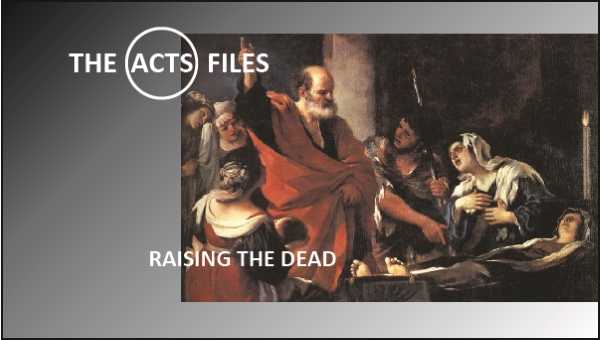By Tyson Thorne

Following the third progress report the narrative then switches from Saul to Peter, and from Caesarea-Maritima to Lydda, in closing out chapter 9. In Lydda Peter heals a man named Aeneas in a humorous fashion. The man had been paralyzed for nearly a decade and confined to his bed. It is clear the man is a believer as he is referenced as being among the “saints” of the city. What does one say to a man confined to his bed for eight years? “Get up and make your own bed”, of course. And Aeneas did just that. All those in Lydda and the nearby plain of Sharon saw him and put their trust in Jesus.
At about the same time in the city of Joppa, about 10.5 miles from Lydda, a Christ-follower named Tabitha became deathly ill and died. We are first informed by Luke that she was a disciple. This means she had some authority and ministered regularly to the church at Joppa. Indeed, we are told she continually performed acts of charity and all other good deeds. Her death was a significant loss to the church and the community.
Hearing that Peter was in nearby Lydda, a group of men left to summon the apostle while others prepared Tabitha’s body for burial. Afterward, her body was placed in an upstairs room to await Peter’s appearance. It is uncertain what they expected of Peter, perhaps they intended to try and persuad him to stay with them until new leadership could be appointed. Whatever their reason, it is doubtful they intended for Peter to participate in the greatest miracle of his life.
Arriving at the deceased’s home Peter was immediately assailed by those whom Tabitha had helped. Many widows were present and anxious to show all the wonderful clothes Tabitha had made them. It wasn’t long before Peter had a complete picture of just how much this disciple meant to the community. What he does next is completely incongruous with his character. Instead of his usual blustery self who enjoyed an audience, Peter humbly sent everyone from the room, knelt down and prayed.
Healing the sick and the lame is one thing, raising someone from the dead is quite another. In the silence of the room he was able to focus and ask God to give this woman back to the church of Joppa. We don’t know if his prayer was confirmed by God, if the Holy Spirit somehow let Peter know his prayer would be answered, or if he spoke his next words wondering if they would be obeyed, but spoke them he did: “Tabitha, get up.”
Her eyes opened and upon seeing Peter she did in fact sit up. Peter, all charm now, offered his hand and helped her up. Opening the door he presented her alive and well to all her family, friends and of course the widows. So joyous was their response that all in Joppa heard about the miracle and many turned to Jesus.
If you have been a believer for long then you are probably aware that Jesus’ resurrection proves his authority in matters of life and death. Even so, it is no trivial matter to bring someone back from the dead. There is a difference between being resurrected and being raised from death, and one that every believer should understand. When one is resurrected, as we all will be, they are given a new body, and a new nature. The body is incorruptible and the will is inclined toward righteousness. When one is raised from death, however, their spirit returns to their corrupted body. There is too little evidence in the Scriptures to know if one keeps their new nature, or if that too is returned to earth untouched. I lean toward the former but have no evidence to back up that opinion.
Tomorrow and next week we will take the time to understand the implications of raising someone from the dead and (hopefully) answer questions you may have had about living on the other side of the veil.
|
|
|